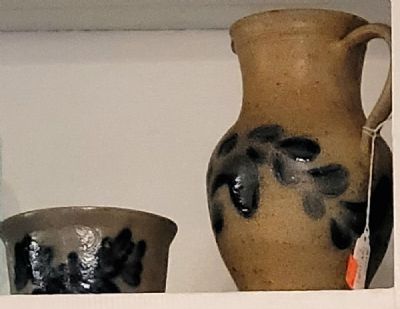What a crock!
While antique stores hold a wide variety of vintage treasures, there is a highly sought-after item that can be
found in nearly every antique store. Stoneware or porcelain crocks are very desirable and collectible, with the
rare and hard to find crocks fetching several hundred dollars or more! Often people will use crocks for
decorative purposes, like holding kitchen utensils, office supplies, make-up, or as a planter. While crocks today
are sometimes used for decorative purposes, there was once a time when having a crock was essential for
storing and preserving food. Stoneware crocks are waterproof and have tight fitting lids that keep out bugs,
insects, rodents, and pets. During the 18 th and up to the 20 th century, crocks were in nearly every kitchen and a
necessity to pioneers traveling across the US heading for Oregon or California. Crocks often held, salted meats,
butter, jelly, grains, pickled items (cucumbers, eggs, peppers, vinegar, etc.) and for fermenting items such as
sauerkraut, kimchi, yogurt, kefir, wine, and cider. The modern invention called a refrigerator helped greatly
with food preservation, along with grocery stores with easier access to food items, eliminated the need to
have large crocks to store food for the winter.
Antique stoneware crocks were made from a variety of clays and fired until hard and non-porous. Crocks came
in many textures and colors, with cream, brown and grey being most common. The potters who made the
crocks often put a “makers mark” onto the bottom or the side of the vessel. The makers mark may have been
a symbol, letters, numbers, a logo, or the name of the manufacturer. Collectors seek out the rarer makers
marks, which are very valuable and hard to find. Vintage vessels often had blue decorative images impressed
into the crock like birds, trees, flowers, decorative lettering, and nearly always had a number. The number on
the sidewall of the crock referred to the size of the crock. For example, the number “3” on a crock meant that
it held 3 quarts, or 3 gallons.
Crocks have been found in archeological digs, with some dating back 10,000 years! Early pots were
earthenware and unglazed, while in the 16 th century Europe, salt glaze was being using on stoneware crocks.
Salt glaze has the texture of an orange peel and is achieved by throwing salt into the kiln during the firing
process. The sodium in salt combines with silica in the clay and forms a non-toxic glassy coating. Prior to the
Revolutionary war in 1775, crocks were imported from England and Germany. Once the war ended, American
potters from mainly New York, New Jersey, and Pennsylvania began making salt glazed crocks, as it was faster
and more cost efficient to manufacture the crocks, rather than import them from Europe.
If someone is looking to acquire a valuable antique crock, it is important to know how to identify vintage
stoneware crocks, as they are still being manufactured and used today. The Amish community is well-known
for their farming and preserving without the use of modern conveniences like electricity, still use crocks for
food storage. Homesteading is very common today, as people are going back to the old ways by growing and
preserving food themselves, and often use crocks. While looking for a crock to purchase on-line may seem like
a good idea because there are many people selling them on various websites, the cost to package and ship the
heavy crock is astronomical! When looking to purchase vintage stoneware crocks, it is best to buy them in
person. The good news is that most antique stores have crocks available for sale.

